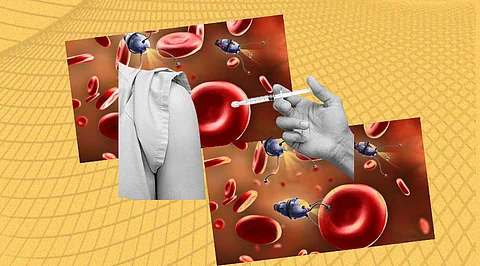Injecting Robots into Bloodstream to Fight Diseases

Australian academics have created a mind-blowing concept that could serve as a proof-of-concept for the future in nanorobotics
What if there was a miraculous robot capable of curing any disease? Don't respond to it. It's a silly question. Everyone understands that no one machine could accomplish such feats. But can a swarm of hundreds of thousands of tiny autonomous micro-bots?
That is the concept advanced by supporters of nanobot medical technology. The big notion in science fiction is usually about constructing tiny metal robots through some type of magic-adjacent miniaturization technology.
Fortunately, the actuality of nanobot technology is considerably cooler. A team of Australian academics has created a mind-blowing concept that could serve as a proof of concept for the future of this sector.
DNA nanobots are nanometer-sized synthetic devices consisting of DNA and proteins. They are self-sufficient because DNA is a self-assembling technology.
Not only does our natural DNA carry the code in which our biology is written, but it also understands when to execute.
Previous research on the subject of DNA nanotechnology has shown that self-assembling devices capable of transferring DNA code, much like its natural counterparts, can be created.
However, the new technology coming out of Australia is unlike anything we've encountered before.
These nanobots are capable of transferring information other than DNA. In theory, they could transport every imaginable protein combination across a biological system.
To put it another way, we should ultimately be able to instruct swarms of these nanobots to hunt down germs, viruses, and cancer cells inside our bodies. Each swarm member would carry a unique protein, and when they come across a harmful cell, they would assemble their proteins into a configuration meant to kill the threat.
It'd be like having a swarm of superpowered killer robots swarming through your veins, hunting for monsters to eliminate.
We're still far from there, but this research is a major step in the right direction. However, this is the first demonstration of a DNA nanobot capable of transporting arbitrary payloads.
In theory, scientists should be able to employ these nanobots to create smart substances that can respond autonomously to stress.
Furthermore, perhaps most excitingly, it may be able to develop fully functional molecular computers in the future utilising DNA nanobots.
All individuals could have molecular computing systems inside their bodies within a century or two. These living robots would essentially construct and operate internal bio-factories that would produce hunter-killer nanobots from the proteins we consume. They'd protect us from diseases for the rest of our lives.
The nice aspect is that these machines would be totally safe. We'd adopt them from our parents' DNA, making them as much a part of us as our lungs or brains.
More Trending Stories
- Shiba Inu Sees Slight Growth Amidst the Cryptocurrency Bloodbath
- Ukraine to Make its Architectural Marvels into NFTs! Only Place Russia can't Destroy
- This Reconfigurable AI Chip Can Put an End to Sustainability Issues
- India's First Multiplex in Metaverse! Airtel hops on a Virtual Path
- Computer-Generated AI Influencers have a Psychological Impact on Humans


